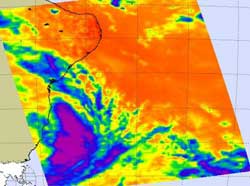NASA's Aqua Satellite spots rare Southern Atlantic sub-tropical storm

On March 14 at 1553 UTC (11:53 a.m. EST) NASA's Aqua satellite captured an infrared image of Sub-Tropical Storm Arani along the Brazilian coast. Most of the convection and thunderstorms (purple) were limited to the eastern half of the storm. Credit: NASA JPL, Ed Olsen<br>
NASA's Aqua satellite spotted some strong convection in a recently formed low pressure area that strengthened into Sub-Tropical Storm Arani in the South Atlantic. Arani formed near the coast of Brazil and is now moving away from it. Tropical cyclones in the Atlantic are a rare occurrence and since 2004 there have only been three of them, Arani being the third.
On March 14, 2011 at 1553 UTC (11:53 a.m. EST) the Atmospheric Infrared Sounder (AIRS) instrument that flies aboard NASA's Aqua satellite captured an infrared image of Sub-Tropical Storm Arani moving away from the Brazilian coast. Most of the convection and thunderstorms were limited to the eastern half of the storm at the time of the image. The strong areas of convection (rapidly rising air that condenses and forms the thunderstorms that power a tropical cyclone) appeared on the imagery as a sideways boomerang, and were off-shore, paralleling the coast.
AIRS measured the temperatures in those strong areas of convection and found they were as cold as or colder than -63 Fahrenheit (-52 Celsius) indicating some strong thunderstorms with heavy rainfall. That heavy rainfall was occurring off-shore. NASA's AIRS imagery is created at NASA's Jet Propulsion Laboratory in Pasadena, Calif.
On March 15 at 1500 UTC (11 a.m. EST), the Brazilian Navy issued a special marine warning for the Brazilian coast. The warning stated that Sub-Tropical Storm Arani was located near 24.0 South latitude and 37 West longitude. Arani had a minimum central pressure of 998 millibars and was moving east-southeast near 10 to 15 knot winds.
Tropical cyclones in the Southern Atlantic Ocean are rare. In 2010 System 90Q formed in the same region where Sub-Tropical Storm Arani formed this year. For more information on System 90Q, visit NASA's Hurricane page archives at: http://www.nasa.gov/mission_pages/hurricanes/archives/2010/h2010_90Q.html.
Dr. Jack Beven of the National Hurricane Center, Miami, Fla. said that Sub-Tropical Storm Arani is not currently as well developed as Tropical Storm Catarina was in the Southern Atlantic in 2004 or System 90Q last year.
The Brazilian Navy has marine forecasting responsibility for that part of the Atlantic designated the system a subtropical cyclone. For updates from the Brazilian Navy on Sub-Tropical Storm Arani, visit: https://www.mar.mil.br/dhn/chm/meteo/indexing.htm. NASA's Hurricane page is managed out of NASA's Goddard Space Flight Center in Greenbelt, Md.
Sub-Tropical Storm Arani is forecast to continue moving away from the Brazilian coast over the next couple of days.
Media Contact
More Information:
http://www.Nasa.govAll latest news from the category: Earth Sciences
Earth Sciences (also referred to as Geosciences), which deals with basic issues surrounding our planet, plays a vital role in the area of energy and raw materials supply.
Earth Sciences comprises subjects such as geology, geography, geological informatics, paleontology, mineralogy, petrography, crystallography, geophysics, geodesy, glaciology, cartography, photogrammetry, meteorology and seismology, early-warning systems, earthquake research and polar research.
Newest articles

How complex biological processes arise
A $20 million grant from the U.S. National Science Foundation (NSF) will support the establishment and operation of the National Synthesis Center for Emergence in the Molecular and Cellular Sciences (NCEMS) at…

Airborne single-photon lidar system achieves high-resolution 3D imaging
Compact, low-power system opens doors for photon-efficient drone and satellite-based environmental monitoring and mapping. Researchers have developed a compact and lightweight single-photon airborne lidar system that can acquire high-resolution 3D…

Simplified diagnosis of rare eye diseases
Uveitis experts provide an overview of an underestimated imaging technique. Uveitis is a rare inflammatory eye disease. Posterior and panuveitis in particular are associated with a poor prognosis and a…





















